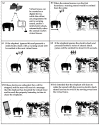Current and Future Approaches to Mitigate Conflict between Humans and Asian Elephants: The Potential Use of Aversive Geofencing Devices
- PMID: 36359089
- PMCID: PMC9653792
- DOI: 10.3390/ani12212965
Current and Future Approaches to Mitigate Conflict between Humans and Asian Elephants: The Potential Use of Aversive Geofencing Devices
Abstract
Asian elephants are a principal cause of human-wildlife conflict. This results in the death/injury of elephants and humans and large-scale crop and property damage. Most current human-elephant conflict (HEC) mitigation tools lack the flexibility to accommodate the ecological needs of elephants and are ineffective at reducing HEC in the long-term. Here we review common HEC mitigation tools used in Asia and the potential of Aversive Geofencing Devices (AGDs) to manage problem elephants. AGDs can be configured to monitor animal movements in real-time and deliver auditory warnings followed by electric stimuli whenever animals attempt to move across user-specified virtual boundaries. Thus, AGDs are expected to condition elephants to avoid receiving shocks and keep them away from virtually fenced areas, while providing alternative routes that can be modified if required. Studies conducted using AGDs with other species provide an overview of their potential in conditioning wild animals. We recommend that the efficacy and welfare impact of AGDs be evaluated using captive elephants along with public perception of using AGDs on elephants as a means of addressing the inherent deficiencies of common HEC mitigation tools. If elephants could be successfully conditioned to avoid virtual fences, then AGDs could resolve many HEC incidents throughout Asia.
Keywords: Elephas maximus; aversive conditioning; human-wildlife conflict; virtual fencing; wildlife management.
Conflict of interest statement
The authors declare no conflict of interest.
Figures

References
-
- Olivier R. Distribution and Status of the Asian Elephant. Oryx. 1978;14:379–424. doi: 10.1017/S003060530001601X. - DOI
-
- Fernando P., Pastorini J. Range-Wide Status of Asian Elephants. Gajah. 2011;35:15–20.
-
- Menon V., Tiwari S.K.R. Population Status of Asian Elephants Elephas maximus and Key Threats. Int. Zoo Yearb. 2019;53:17–30. doi: 10.1111/izy.12247. - DOI
-
- Sukumar R. A Brief Review of the Status, Distribution and Biology of Wild Asian Elephants Elephas maximus. Int. Zoo Yearb. 2006;40:1–8. doi: 10.1111/j.1748-1090.2006.00001.x. - DOI
-
- Gogoi M. Emotional Coping among Communities Affected by Wildlife-Caused Damage in North-East India: Opportunities for Building Tolerance and Improving Conservation Outcomes. Oryx. 2018;52:214–219. doi: 10.1017/S0030605317001193. - DOI
Publication types
Grants and funding
LinkOut - more resources
Full Text Sources
Other Literature Sources

